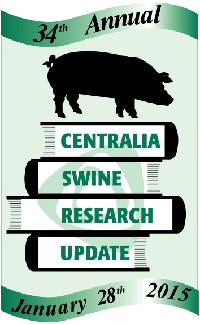



Environmental Enrichment for Growing Swine
Delegates to the Centralia Swine Research Update 2015 heard the results of an experiment with Ontario farmers on the practical use of two types of toy that attracted plenty of interest from nursery and growing pigs.
Environmental enrichment is a component of swine welfare. Enrichment devices are necessary according to the 2014 Canadian Code of Practice for the Care and Handling of Pigs. Some Ontario swine producers incorporate enrichment devices such as tyres, bowling balls, and hanging chains for growing pigs. These items tend not to sustain pig interest over time.
A field study reported by Heather Neureuther of Ontario Veterinary College at the University of Guelph and Tim Blackwell of OMAFRA was designed to compare two environmental enrichment devices on 11 commercial swine farms with respect to durability, maintenance requirements and ability to sustain pig interest.
One enrichment device utilized a teeter totter style design (TT). This device is attached to a pen dividing wall and has attachments that hang off the arms of the teeter totter into the adjoining pig pens. The second device (TS) hangs from the ceiling of a pen and has three plastic arms extending from the center of the apparatus. Half of the devices had a bell attached to test whether noise increases pig interaction with the toys. Consequently, two variations on each of the two distinct toys were tested in this trial: TS and TS with bell, TT and TT with bell.
Each of the 11 cooperating farms received two of each type of toy (total of eight toys per farm) installed in either nursery, wean to finish and/or grower/finisher pens. Farmers recorded the number of pigs playing with each toy during a point-in-time observation period, approximately one minute in length, every morning and afternoon for a four-month period.
This study revealed that while both toy designs sustained pig interest for the duration of the study, the TS had a greater percentage of pigs interacting with it, but required more maintenance than the TT.
It is hypothesised that more pigs played with the TS because it could be accessed from all sides, allowing a larger number of pigs to play at one time, compared to the TT which required mounting on the pen wall. While the TS was a more popular toy, it also required more maintenance as the plastic arms were completely chewed off when placed in finisher pens. Nevertheless, pigs continued to play with the TS even when all arms were removed.
The ability to produce noise did not influence the proportion of pigs that played with either toy.
Pig interest in the toys increased whenever changes were made. For example, replacing the plastic arms of the TS resulted in an immediate increase in pig interaction. A marking trial performed on four farms showed that all the pigs in a pen will take turns playing with the toys over time.
Producer feedback on a survey following the completion of the trial indicated that nine of the 10 responding producers would incorporate these devices into their pig pens to meet the Code of Practice requirements for environmental enrichment.
The results of this study may be useful to swine practitioners as a reference for the designs and materials that function well as swine environmental enrichment devices. The requirement of providing environmental enrichment in all swine pens can be frustrating for producers to fulfill. This study identified two enrichment devices that sustain pig interest while remaining inexpensive and durable.
Access a 10-minute video on this project by clicking here.
Reference
Neureuther H. and T. Blackwell. 2015. Environmental enrichment for growing swine. Proceedings of 34th Annual Centralia Swine Research Update. 28 January 2015. I17.
April 2015








